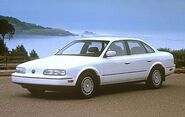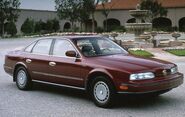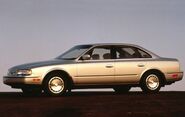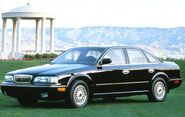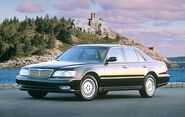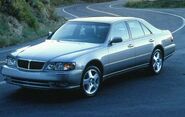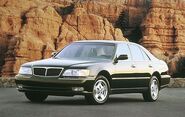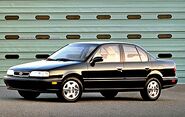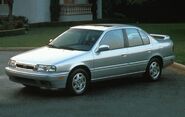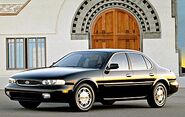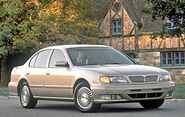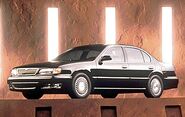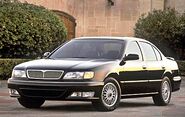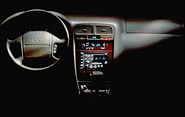(Editing a gallery) |
|||
| Line 30: | Line 30: | ||
94infinitiq45.jpg|1994 Infiniti Q45 4-door sedan |
94infinitiq45.jpg|1994 Infiniti Q45 4-door sedan |
||
95infinitiq45.jpg|1995-1996 Infiniti Q45 4-door sedan |
95infinitiq45.jpg|1995-1996 Infiniti Q45 4-door sedan |
||
| + | 97infinitiq45.jpg|1997 Infiniti Q45 4-door sedan |
||
| + | 98infinitiq45.jpg|1998 Infiniti Q45 4-door sedan |
||
| + | 99infinitiq45.jpg|1999 Infiniti Q45 4-door sedan |
||
| + | 98infinitiq45t.jpg|1998-1999 Infiniti Q45t 4-door sedan |
||
</gallery> |
</gallery> |
||
Revision as of 13:19, 25 July 2014
Infiniti M30
1991
The Infiniti M30 was one of the first cars ever produced from Nissan Motor Company's Infiniti luxury division. It was sold as either a 2-door convertible or a 2-door coupe.
1992
After this year, the M30 was never seen again, and for a long time, no new coupes or convertibles were ever made, despite the fact that Infiniti originally planned to introduce a new 2-door coupe and a convertible derived from its successor, the J30.
Infiniti Q45
1991
The Infiniti Q45 was Infiniti's first 4-door sedan ever produced.
In some ways, the Q45 and arch-rival Lexus LS 400 were the most important automobile models since the beginning of the '90s. They introduced the new "softer, gentler" way of marketing cars, proved that Japanese companies can build world-class luxury sedans, raised consumer satisfaction to previously new heights and also provided some fine automobiles to their lucky owners. The first cars were sold at around $38,000.
1994
Thanks to the weakening value of the dollar compared to the yen, Q45 prices have skyrocketed to $50,900 in 1994, but they were still competitive with the BMW 540i, Mercedes-Benz E420 and Jaguar XJ6. Physically, the Q45 was as large or larger than any of its competitors and, thanks to its 278-hp V8, capable of the same 150-mph performance.
The Q45 was given a new Jaguarlike grille, an airdam with auxiliary foglights, larger headlights, different taillights and more eye-catching trim. The leather-covered interior featured a 10-way power driver's seat and 8-way power passenger seat, both with power head restraints, a fancy Bose sound system and many other convenience features.
The sophisticated rear-drive chassis became standard with a limited-slip differential, power steering and ABS disc brakes. There were two upgrade packages sold as separate models: The Q45t added alloy wheels and a CD changer. The Q45a had traction control and the only truly active suspension system available on a production car. Traction control was an option on the other models. Bottom line, the Q45 was big, fast, comfortable and competitive with European 4-door luxury and sport sedans that costed twice as much.
1997
The Q45 was redesigned for its second generation.
Infiniti G20
1991
Infiniti's G20 was basically a restyled Nissan Sentra on a slightly stretched platform that was priced high enough to compete with import sedans like the Acura Vigor, Lexus ES 300 and BMW 318i. That's a tall order for a Japanese economy car. The G20, on the other hand, was a delight, a secret sport sedan loaded with extras.
A lot of its appeal came from the 140-hp dohc 4-cylinder it shared with the sporty Sentra SE-R. This was one of the nicest engines Nissan made, smooth, powerful and happy to rev. This car also included the 5-speed manual gearbox for maximum fun and utility. Its 4-speed was unique in that it shifts from Comfort mode to Power mode when tramping on the accelerator.
The G20 also included standard equipment like power steering, CFC-free air conditioning, a 160-watt sound system, alloy wheels and 4-wheel disc brakes with ABS. In all, almost 14,000 Infiniti G20s were sold in 1991.
1995
New for 1995 was the G20t, a high-performance package that costed $2900 extra but added a limited-slip differential, foglights, rear spoiler and stickier tires, as well as a leather-upholstered interior, power front seats, power sunroof and remote keyless entry. Other thoughtful refinements included a cargo net in the trunk and height-adjustable rear headrests.
1996
After 1996, the G20 remained off the lineup for two years.
1999
When reintroduced for the 1999 model year, the G20 was also redesigned upon undergoing several changes.
Infiniti J30
1993
Replacing the old Infiniti M30 was the J30, a mid-size 4-door sedan. It competed with the Lexus GS 300, BMW 5-series and Mercedes C-Class cars. Its rear-drive chassis was finely balanced, and the dohc 3.0-liter V6 both smooth and powerful. ABS disc brakes and all-season tires were standard equipment.
Also standard were a limited-slip differential, speed-sensitive power steering and a 4-speed electronically controlled automatic transmission with interactive engine-transmission coordination to eliminate shift harshness. The top-line J30t added alloy wheels, V-rated tires and a rear spoiler that altered the controversial rounded trunk silhouette of the J30.
Like other cars in this class, the J30 came equipped with every imaginable feature, including leather upholstery, 8-way power seats, a Bose sound system with CD player, automatic climate control, remote keyless entry and a power trunklid release. The car itself was only 2 in. shorter than a full-size BMW 740i.
1997
The J30 was discontinued after 1997.
Infiniti I30
1996
Just as Infiniti's entry-level G20 was based on the small Nissan Sentra, the mid-size I30 was based on the Nissan Maxima. Model for model, the I30 was roughly $10,000 more than the comparable Maxima, which moved it into competition with the Lexus ES 300, Mercedes-Benz C-Class and the Oldsmobile Aurora. Infiniti offered a 4-year/60,000-mile warranty, significantly longer than Nissan's 3 year/36,000. The I30 had a shiny grille similar to the one used on the Q45, prettier alloy wheels and slightly different front bumper cover. Everything else, even the tires, was much the same.
The I30 came in three trim levels, corresponding almost precisely to the Maxima's GXE, GLE and SE packages. The I30 Standard was equipped with automatic climate control, power windows and locks, cruise control, a 200-watt Bose sound system with CD player and a 5-speed manual transmission. A 4-speed automatic and power glass sunroof were among the options.
Next up was the I30 Leather-Appointed. It included leather upholstery, automatic transmission, glass sunroof and the HomeLink transmitter to automatically open any house's garage door and turn on lights before entering a driveway. Optional were a limited-slip differential and heated seats. The sportiest I30 was the Touring, or I30t, which came standard with more aggressive all-season tires, firmer suspension, forged alloy wheels, traction control, heated seats and a rear spoiler. A 5-speed manual transmission was standard, with a 4-speed automatic optional.
